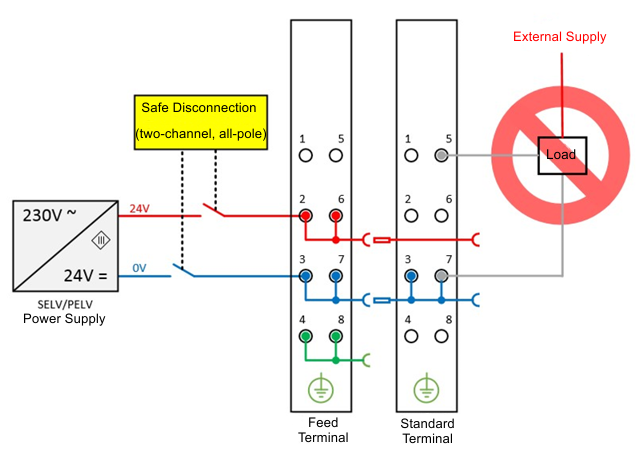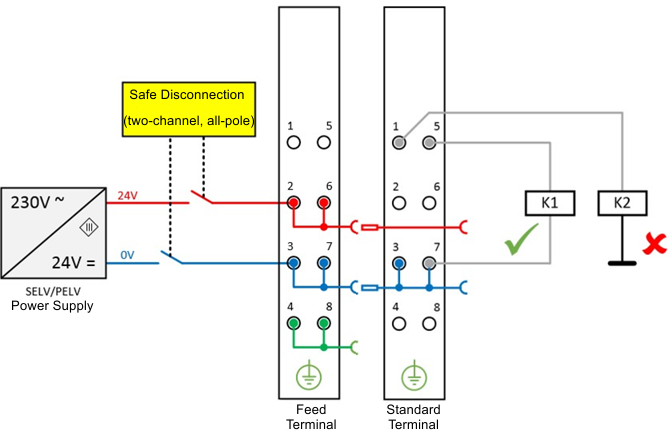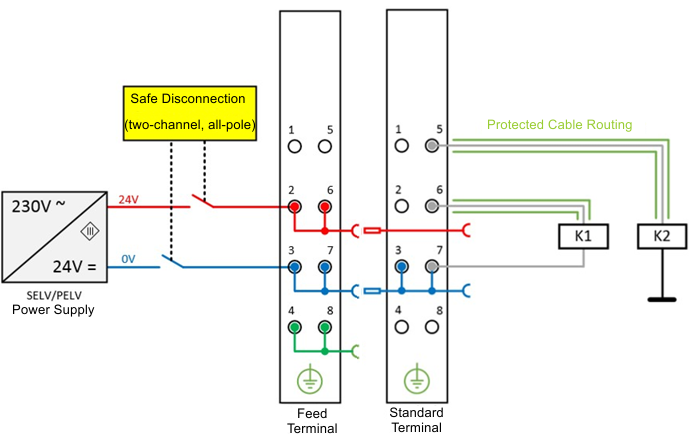Interference-free Bus Terminals
 | Use of interference-free Bus or EtherCAT Terminals in safety applications If a Bus or EtherCAT Terminal is described as interference-free, this means that the consecutive terminal behaves passively in a safety application (e.g. in the case of the all-pole switch-off of a potential group). |
Please pay attention to the information about the hardware version and non-reactivity of the respective Bus Terminal in the chapters "Technical Data" or "Firmware Compatibility"!
Only terminals with the appropriate hardware version may be used without the attained SIL/PL being affected!
The Bus or EtherCAT Terminals regarded as interference-free at the time of preparing this document are listed in the following tables together with their respective hardware versions.
Terminal name | from hardware version |
|---|---|
KL2408 | 05 |
KL2809 | 02 |
KL2134 | 09 |
KL2424 | 05 |
KL9110 | 07 |
Terminal name | from hardware version |
|---|---|
EL2004 | 15 |
EL2008 | 07 |
EL2022 | 09 |
EL2024 | 06 |
EL2034 | 06 |
EL2809 | 01 |
EL2828 | 00 |
EL2872 | 01 |
EL2878-0005 | 00 |
EL9110 | 13 |
EL9410 | 16 |
ELX1052 | 00 |
ELX1054 | 00 |
ELX1058 | 00 |
ELX2002 | 00 |
ELX2008 | 00 |
ELX3152 | 00 |
ELX3181 | 00 |
ELX3202 | 00 |
ELX3204 | 00 |
ELX3252 | 00 |
ELX3312 | 00 |
ELX3314 | 00 |
ELX3351 | 00 |
ELX4181 | 00 |
ELX5151 | 00 |
ELX9560 | 03 |
External wiring
The following requirements are to be ensured by the system manufacturer and must be incorporated into the user documentation.
- Protection class IP54
The terminals must be installed in IP54 control cabinets to ensure the necessary protection class IP54. - Power supply unit
The standard terminals must be supplied with 24 V by an SELV/PELV power supply unit with an output voltage limit Umax of 60 V in the event of a fault. - Prevention of feedback
Feedback can be prevented through different measures. These are described below. In addition to mandatory requirements there are also optional requirements, of which only one needs to be selected. - No switching of loads with a separate power supply
Loads that have their own power supply must not be switched by standard terminals, since in this case feedback via the load cannot be ruled out. 
Negative example – active load - The control of an STO input of a frequency converter could serve here as a negative example.
Exceptions to the general requirement are allowed only if the manufacturer of the connected load guarantees that feedback to the control input cannot occur. This can be achieved, for example, through adherence to load-specific standards. - Option 1: Ground feedback and all-pole disconnection
The ground connection of the connected load must be fed back to the safely switched ground. 
Ground connection of the load: correct (K1) and incorrect (K2) - If either
a) the ground of the load is not fed back to the terminal or
b) the ground is not safely switched but connected permanently
then fault exclusions are necessary with regard to a short-circuit with external potential in order to be able to achieve Cat. 4 PLe according to EN ISO 13849-1:2007 or SIL3 according to IEC 61508:2010 (refer here to the overview in the chapter "Effect of options on the safety level"). - Option 2: Cable short-circuit fault exclusion
If solution option 1 is not feasible, the ground feedback and all-pole disconnection can be dispensed with if the danger of feedback due to a cable short-circuit can be excluded by other measures. These measures, which can be implemented alternatively, are described in the following sections. 
Short circuit fault exclusion through protected cable laying - a) Possibility 1: Load connection via separate sheathed cables
The non-safely switched potential of the standard terminal may not be conducted together with other potential-conducting cores inside the same sheathed cable. (Fault exclusion, see EN ISO 13849-2:2013, Table D.4) - b) Possibility 2: Wiring only inside the control cabinet
All loads connected to the non-safe standard terminals must be located in the same control cabinet as the terminals. The cables are routed entirely inside the control cabinet. (Fault exclusion, see EN ISO 13849-2:2013, Table D.4) - c) Possibility 3: Dedicated earth connection per conductor
All conductors connected to the non-safe standard terminals are protected by their own earth connection. (Fault exclusion, see EN ISO 13849-2:2013, Table D.4) - d) Possibility 4: Cable permanently (fixed) installed and protected against external damage
All conductors connected to the non-safe standard terminals are permanently fixed and, e.g. protected against external damage by a cable duct or armored pipe. - Effect of the options on the safety level
In principle, standard terminals in safely switched potential groups are not an active part of the safety controller. Accordingly, the safety level attained is defined only by the higher-level safety controller, i.e. the standard terminals are not included in the calculation! However, the wiring of the standard terminals can lead to limitations in the maximum attainable safety level.
Depending on the solution selected for the avoidance of feedback and the safety standard considered (see Option 1 and Option 2), different maximum attainable safety levels result, which are summarized in the following table:
Summary of safety classifications
Feedback avoidance measures | DIN EN ISO 13849-1 | IEC 61508 | EN 62061 |
|---|---|---|---|
Fault exclusion Cable short-circuit | max. Cat. 4 PLe | max. SIL3 | max. SIL2 * |
Ground feedback and all-pole disconnection | max. SIL3 |